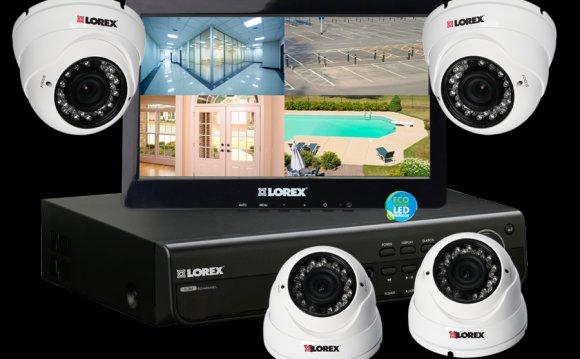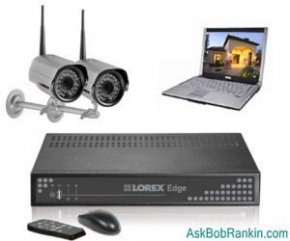
Closed-circuit TV (CCTV) security camera systems are the tried-and-true technology for surveillance monitoring at homes and businesses. Older models still use video tapes to store the action they record - or, more often, the lack of action. Video tape in older CCTV camera security systems may run continuously, recording perfectly ordinary and forensically useless scenes. If a particular event (such as a break-in) must be found there's a lot of fast-forwarding and rewinding to do.
More modern and efficient CCTV tape systems are motion-activated; the cameras do not record unless something of at a least a specified minimum size moves within their range. Such camera surveillance systems can be fine-tuned to ignore branches, chipmunks, cats, small dogs, etc. In this way, only potentially relevant video is stored and has to be reviewed. You may still get burglarized by a trained carrier pigeon, but that's a risk you'll have to accept with the newer technology.

Many CCTV home security system cameras use looped tapes that record over their previously stored footage continuously. You need not remember to load a fresh tape when one is full, and you don't end up with a garage full of tapes. Just be sure a looped tape can store a useful amount of footage, such as a week's worth, whether you use continuously-filming or motion-activated cameras.
Digital and Wireless Security Cameras
Digital security camera systems have some advantages over tape. First, they can store much more footage in the same physical space because they use hard drives to store digital video files; a hard drive of sufficient capacity can store HD video that reveals every detail of activity. Second, it is easier and faster to access a random segment of a video stream in digital form, as anyone who's played with the slider control on a YouTube video knows. Third, digital video can be enhanced easily with editing software to bring out details such as a license plate or a burglar's tattoo. Taped footage must be converted to digital format before it can be enhanced, and that's a time-consuming task.
Wireless home security systems have radio transmitters built into their cameras along with a monitor and/or recording base station. Cameras can be placed anywhere around the house very easily without running cables through walls and ceilings. Wireless security cameras can be monitored on a standard television or they can even stream video to your smartphone or computer via the Internet. This capability enabled a vacationing couple to thwart an attempted burglary even though they were 1, 400 miles from their home!
Home security camera systems can be installed by professional security companies such as ADT or Broadview Security (formerly Brinks). But they are also widely available at Radio Shack and other electronics stores, and from many online vendors. Installing modern home security cameras, particularly wireless ones, requires little or no technical skills. Don't be afraid to try it yourself.
One of the easiest systems to use and install is the Dropcam. In my article Dropping in With Dropcam, I describe this little wonder that streams HD video wirelessly, and has two-way audio. The $149 gadget is a snap to set up, and can send video to your smartphone, laptop, or a cloud-based DVR service.
is a low-end example, starting at under $100. It comes with one wireless color camera that can transmit up to 200 feet, a receiver, and hardware to connect to your TV. It also features night vision and audio detection notification, and the ability to add an additional camera. The downside is that this system doesn't record surveillance video that can be reviewed later, and you can't access the camera remotely via the Internet.
($149) lets you easily add a surveillance camera to your home or small office network, and setup is a snap. This surveillance camera can monitor in the day or at night. To view what the camera is seeing, you can use a web interface or a smartphone app. This is an ideal low-cost solution for those who want to peek in on what's happening at home while they're at work, out for the evening, or on vacation. You can also use the D-ViewCam software to view, record and play back surveillance video.
(about $100) is an IP camera for OUTDOOR use. The night vision capability uses 60 infrared LED's to record up to 30 meters out in absolute darkness. It transmits live video and audio over the internet to a web browser, smartphone or local network. Video is transmitted at 30fps with an image resultion of 640x480. The camera can be controlled remotely using your browser.
sells for around $249, and has some unique features. You can remotely pan the camera 340 degrees side-to-side and tilt 115 degrees up and down, using an Internet connection. The night vision feature can record in complete darkness for distances up to 7.5 meters. Video recording resolution is sharp, at 1280x800 megapixels and 30 frames per second (fps). Two-way audio lets you scare the pants off an intruder, or sing your cat to sleep. The included software allows for scheduled recording times, email alerts and can manage up to 32 cameras.
which includes four wired night-vision weather proof cameras, and a receiver with built-in DVR for recording and playback. This system supports local viewing and live video streaming over the internet to your PC, Mac or smartphone. As I write this, the price is listed at $299, discounted from the regular price of $699. They also sell wireless camera systems with 2 to 4 indoor/outdoor cameras.
DIY and CYA
For the geeky do-it-yourself types, there is a free Linux-based software tool called Motion. You'll need a computer running the free Linux operating system and one or more webcams (wired or wireless) which can be purchased for about $10 each. Motion takes snapshots at pre-defined intervals, and when it detects motion, it wakes up and creates a short video to catch the action. The program has many advanced features, is highly customizable, and well supported by the author. If you have an older computer that's gathering dust, your cost for a basic home security/surveillance system running the Motion software could be as low as $10.








